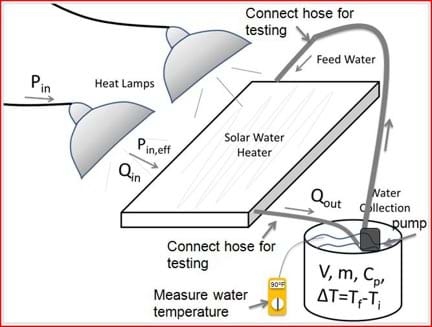Materials List:
Solar Water:
Heat it Up!
 https://www.teachengineering.org/activities/view/cub_solarenergy_lesson01_activity1
https://www.teachengineering.org/activities/view/cub_solarenergy_lesson01_activity1
Heat it Up!
For solar water heater construction, each group needs access to:
- drills
- hand saws
- hot glue guns
- hammers
- box cutters
- scissors
Groups should also have access to as many of the following building material options as possible:
- newspaper
- tar paper
- plexiglass
- 2" x 4" wood
- plywood
- ¼" ID clear plastic tubing, available at hardware stores
- 5/8" ID PVC
- 5/8" PVC elbow/T connectors
- ¼" ID black rubber hosing
- black spray paint
- cardboard
- zip ties
- hot glue sticks
- duct tape
- rigid insulation
- nails
- screws
- aluminum foil
- bubble wrap
- 14 gauge wire
- 4 mm clear plastic sheeting
- plastic wrap
Testing station materials (Note: it is recommended to have one testing station per group):
- 2 250-Watt heat lamps (heat lamps need to be placed on stands; try using chemistry lab stands with clamps so students can position the lamps to their liking)
- submersible fountain pump with adjustable flow control (aim for maximum flow rate of 130 gallon per minute, gpm; make sure pump is completely submerged throughout the entire test)
- a container that holds at least 1 gallon of water (make sure water completely submerges fountain pump)
- a temperature probe or thermometer
- stopwatch
- hose connections to connect the testing station tubing and the solar water heater tubing (students are given the option of using PVC, hosing or clear tubing, so the testing set-up must be able to adapt to the different connections between the water heaters and the hosing for pumping and draining the water into the container; see Figure 1)
 https://www.teachengineering.org/activities/view/cub_solarenergy_lesson01_activity1
https://www.teachengineering.org/activities/view/cub_solarenergy_lesson01_activity1